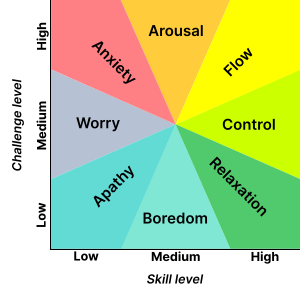Achieving peak performance and intense concentration requires maintaining an optimal level of physical arousal that is in line with the demands of the competitive situation. However, this can be a delicate balance as there is a fine line between being too stimulated and not being stimulated enough. Thus, managing your arousal level is a vital part of your mental preparation, and it is important to fully comprehend this concept.

Different Approaches for Different Tasks
Whether weightlifting, performing gymnastics, playing football or golf, the psychology behind each of these activities may differ. Your optimal arousal level is dependent on the task at hand, and so the right kind of psyching up can be helpful if utilized at the right time and in the right way
Here's an example of how a sports performer or athlete can use NLP modeling and breath work to control their arousal levels:
First, the athlete would identify their optimal level of arousal for their sport or performance. This could be done by reflecting on previous successful performances and the state of mind they were in at the time.
The athlete could then use NLP modeling techniques to create a mental image of themselves performing at their optimal level. This could involve imagining the sights, sounds, and sensations of being in the moment and achieving their goal.
Once the athlete has a clear mental image of their desired state, they can use breath work to help control their arousal levels. For example, they could practice slow, deep breathing to lower their heart rate and reduce anxiety or stress.
Case Study
A client came to me seeking help with their golf game. They told me that they often struggled to stay focused and confident during tournaments, and that their performance suffered as a result.
I suggested that we try using NLP modeling, The Tunnel, and breath work techniques to help them control their arousal levels and achieve their optimal state of mind for golf.
First, I used The Focused Awareness Technique, then we identified their optimal level of arousal for golf, which they determined was feeling alert and focused, but not overly tense or anxious. Then, we used visualization techniques as shown in this program to create a mental image of them playing their best golf, which involved visualizing themselves standing on the tee, feeling relaxed and confident as they lined up their shot, and imagining the ball soaring through the air and landing perfectly on the green.
Next, we practiced slow, deep breathing to help them relax and stay focused during the tournament. I suggested that they take a few deep breaths before each shot to help maintain their optimal level of arousal.
If they noticed that they were starting to feel too relaxed or unfocused, we used "power breathing" techniques to increase their heart rate and activate their nervous system. This involved taking quick, shallow breaths or practicing a "breath of fire" technique to energize them.
We used an NLP Triger technique to associate a specific gesture or word with their optimal state of mind. I suggested that they touch their thumb and index finger together and say the word "focus" to trigger a feeling of relaxation and concentration.
Finally, we used The Tunnel Technique to help him stay focused
By using these techniques, my client learned to control their arousal levels and stay in their optimal state of mind for peak performance on the golf course.
